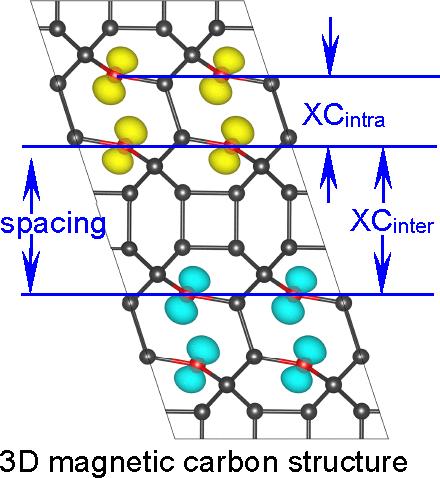碳同素异形体原子基磁性的统一理论
IF 4.6
2区 化学
Q2 CHEMISTRY, PHYSICAL
引用次数: 0
摘要
传统的碳同素异形体,如石墨烯、金刚石、纳米管和富勒烯,通常是非磁性的。然而,最近对本征磁性的实验观察对传统理论提出了挑战。磁性碳结构的微观起源、交换相互作用和设计策略,特别是三维(3D)同素异形体,仍然难以捉摸。在这里,结合第一性原理计算和杂化轨道分析,我们建立了一个统一的框架,表明磁性是由具有弯曲sp-sp2或三角金字塔sp2-sp3杂化的原子群中未杂化的2p轨道的对称破断产生的。与传统的以原子为中心的磁性理论不同,我们基于原子群的范式系统地预测了从零维到三维系统的磁性碳同素异形体。我们进一步提出了一般的设计策略,并预测了一类亚稳态二维和三维相,它们具有固有的流动铁磁性或反铁磁性。这些发现为p块磁性理论奠定了基础,并为自旋电子和量子材料的设计开辟了道路。本文章由计算机程序翻译,如有差异,请以英文原文为准。

Unified Theory of Atomic-Group-Based Magnetism in Carbon Allotropes
Traditional carbon allotropes, such as graphene, diamond, nanotubes, and fullerenes, are typically nonmagnetic. However, recent experimental observations of intrinsic magnetism challenge conventional theories. The microscopic origin, exchange interactions, and design strategies for magnetic carbon structures, particularly three-dimensional (3D) allotropes, remain elusive. Here, combining first-principles calculations with hybrid orbital analysis, we establish a unified framework showing that magnetism arises from symmetry breaking of unhybridized 2p orbitals within atomic groups exhibiting bent sp-sp2 or trigonal pyramidal sp2-sp3 hybridizations. Distinct from conventional atomic-centered magnetism theories, our atomic-group-based paradigm systematically predicts magnetic carbon allotropes from zero-dimensional to 3D systems. We further propose a general design strategy and predict a family of metastable two-dimensional and 3D phases displaying intrinsic itinerant ferromagnetism or antiferromagnetism. These findings lay the groundwork for a p-block magnetism theory and open avenues for spintronic and quantum material design.
求助全文
通过发布文献求助,成功后即可免费获取论文全文。
去求助
来源期刊

The Journal of Physical Chemistry Letters
CHEMISTRY, PHYSICAL-NANOSCIENCE & NANOTECHNOLOGY
CiteScore
9.60
自引率
7.00%
发文量
1519
审稿时长
1.6 months
期刊介绍:
The Journal of Physical Chemistry (JPC) Letters is devoted to reporting new and original experimental and theoretical basic research of interest to physical chemists, biophysical chemists, chemical physicists, physicists, material scientists, and engineers. An important criterion for acceptance is that the paper reports a significant scientific advance and/or physical insight such that rapid publication is essential. Two issues of JPC Letters are published each month.
 求助内容:
求助内容: 应助结果提醒方式:
应助结果提醒方式:


